-

人教版高中地理必修2煤城焦作出路何在说课稿
分析过焦作市的地理概况和产业优势后,就需要针对由于资源枯竭所带来的问题提出合理化的建议。既然是谈经济转型,就应该将话题的范围明确在这一领域内。通过材料3的相关内容,我们了解到焦作市需要在产业结构调整、培育新的优势产业、增强综合竞争力等三个整改方针上下功夫。因而引导学生针对优势与不足提出建议,以三个整改方针为基准,衡量建议的可行性是锻炼学生解决此类问题的有效途径。在此我将教会学生的是解决问题方法而非案例的内容,正所谓“授之以鱼,不如授之以渔”。接下来针对学生的建议和教材资料分析所罗列的10点整改思路,由学生自由发言提出看法,通过教师的指导和学生的讨论,进而确定经济转型建议的具体方案。最后注意将建议与产业优势相对照,看建议是否都是围绕着产业优势而提出的,这样做会加深学生的印象,通过建议和优势的对应关系,将不难找出此类问题的解题思路。
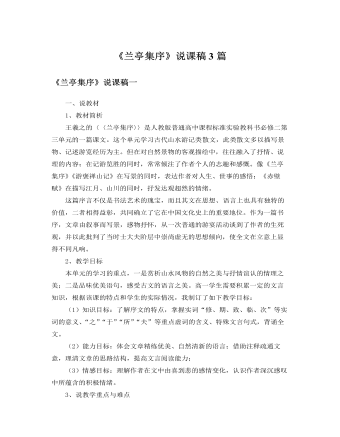
人教版高中语文必修2《兰亭集序》说课稿3篇
(二)分析课文,理清思路第1、2段为第一部分,主要是叙事、写景,先叙述集会的时间、地点,然后渲染出兰亭优美的自然环境。在这里足以“游目骋怀”“极视听之娱”,可以自由地观察、思考,满足人们目视耳闻的需求。这里正是与会“畅叙幽情”、尽兴尽欢的绝好处所。这些描写都富有诗情画意,作者的情感是轻松愉快的。第3、4段为第二部分,主要是抒情、议论,作者由美景妙时引发出乐与忧、生与死的感慨。他认为人生的快乐是有极限的,待快乐得到满足时,就会感觉兴味索然。往事转眼间便成为历史,人到了生命的尽头就会死亡。作者由“一死生为虚诞,齐彭殇为妄作”的认识,产生了一种珍惜时间、眷恋生活、热爱文明的思考。虽然文中的寿夭、生死不能自由决定,从而有些伤感,但作者仍然认识到盛衰、生死是必然的。人生无常,时不我待,故著文留传后世,以承袭前人,启示来者。

人教版高中语文必修2《游褒禅山记》说课稿3篇
学法指导:高一学生对文言文阅读已具备了一些基础知识和积累,但对如何学习文言文,还是一个新课题,因此教师应引导学生掌握学习方法,运用已有的知识框架同化新信息,建立新的智能,逐步走向独立学习的境界。一、引导学生利用课文注释,使用工具书自己翻译,必要时教师进行点拨、解难,培养自学能力。二、告诉学生翻译文言文要遵循的原则。三、调动学生思考、讨论、交流的积极性,教师适时点拨,培养学生发现问题、解决问题的能力。四、提示学生反复诵读课文,体会文章所阐述的道理。五、鼓励学生及时归纳学习文言文的方法,注意积累文言文知识。教学程序:教学本课可安排2课时。第一课时:1、导入新课:首先给学生介绍毛泽东的七绝诗《为李进同志题所摄庐山仙人洞照》:“暮色苍茫看劲松,乱云飞渡仍从容。天生一个仙人洞,无限风光在险峰。”学生通过诵读领会了“无限风光在险峰”一句的含义。随后因势利导,引出课题,指出今天我们要学习的王安石的《游褒禅山记》,就含有类似的深邃哲理。
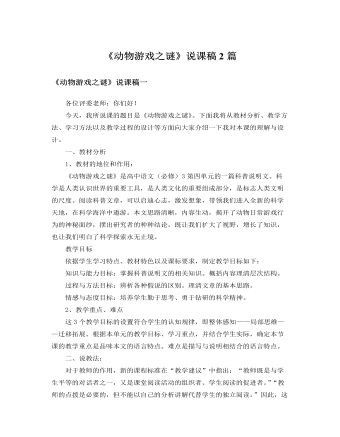
人教版高中语文必修3《动物游戏之谜》说课稿2篇
一、导入新课人类社会越来越现代化,新科学技术日新月异,令人目不暇接,称之到了“知识爆炸”的时代也毫不为过。由此而来的是生活的快节奏,学习和工作的竞争也越来越激烈。这种竞争一直波及到了儿童,加之中国几千年来形成的望子成龙的传统观念,使作父母的把一切希望都寄托在孩子身上,实现自己未能实现的理想。祖孙三代4、2、1的局面,使12只眼睛都盯在了孩子身上,真是走路怕摔着,吃饭怕噎着,干活怕累着,要星星不敢摘月亮,要吃什么跑遍全城也要买来。这种过分保护、溺爱及过早地灌输知识会得到什么结果呢?乐观者说孩子越来越聪明,越来越早熟,将来能更好适应现代化的要求;悲观者则认为豆芽菜式的孩子将来经不起风浪,小皇帝太多了很难凝聚成统一力量,将来谁去当兵,谁去干那些艰苦创业性工作……。对孩子本身来说,是幸福还是……在此不想多发议论,还是让我们来看看动物世界的孩子们吧,也许会得到某种启迪。
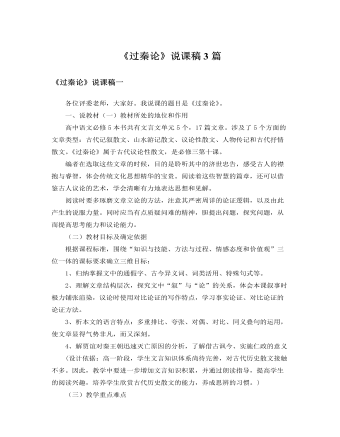
人教版高中语文必修3《过秦论》说课稿3篇
本文篇幅较长,并且有一字句不易理解,因而对高一学生来说完全读懂内容有一些困难。这样的话,老师就要做好引导工作,把一些难点,或是出现词类活用比较多,局势比较特殊的句子,老师可以先给学生画出来,存疑,或是与同学们一起讨论解决。对那些不易懂的字词就引导学生联系上下文提供的语境、前后涉及的情节加以推测、判断,以培养学生依据文脉推断词义的好方法。要求学生点出重点实词、框出通假字,主要是为帮助学生积累和掌握一些文言文中常见的一词多义、异读现象、古今异义和通假现象的词语,并进一步得出规律,指导今后的文言文学习。词类活用和特殊句式在文言文翻译中难度较大,也是本文教学的两大难点。要求学生标出有活用现象的字和划出句式特殊的句子,是基于两点考虑:1、积累一定数量的第一手例句;2、引导学生加以分类,找出每类的相同特征,并抽取出来形成规律性的东西,从而上升到理性认识,使学生能由学会一个到会学多个。翻译过程中注重指导学生养成用符号法表示重点字句的好习惯,如点、框、圈、划线等符号应约定一致,便于突出翻译中的重点、难点及复习。我的提示着重归纳了实词“制”“亡”“遗”“利”等,名词活用、形容词活用、使动用法,被动句、状语后置句。
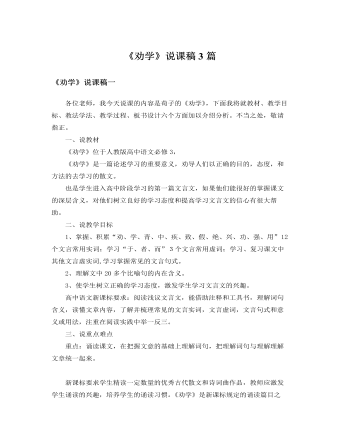
人教版高中语文必修3《劝学》说课稿3篇
《劝学》是普通高中课程标准试验教科书语文必修三第三单元的重点篇目,该文集中反映著名思想家荀子在学习问题上的观点和精彩斐然的论证艺术。该单元所选课文都是古代的议论性散文。通过本单元的学习在于让学生感受我国传统文化的精神,掌握基础的文言语法知识,学习如何清晰有力的表达自己的思想和见解。本文安排在单元的第一篇,如何指导学生学好这篇课文,是实现“授之以渔”,树立学生学好文言文的信心,掌握文言学习方法的关键。根据新课标倡导从“知识与能力”、“过程与方法”、“情感态度与价值观”三方面出发设计课程目标的要求和高一的学生对于文言文的知识还在积累的阶段,应该注重基础知识的积累和一定量的诵读的实际情况。我拟确定以下教学目标:1,了解荀子论述学习的思想,明确学习要靠积累、坚持不懈、专心致志的道理。2,掌握积累文言实词、虚词,活用、古今异议等现象和固定句式。

人教版高中英语必修1Journey Down the Mekong说课稿
2. let the Ss complete the forms paragraph by paragraph. Purpose here is to help Ss to get the habit of reading a passage as a whole, and pay attention to the organization of the text, as a result the Ss will fully understand the whole passage.3. ask Ss to retell the passage with the help of the key words in the form.Since the Ss in the class are in different levels, so I let them to fill in the blank to understand the meaning of the words and phrases better. ( That’s all for the while-reading. Now let’s move to the fifth step.)Step V: Post-reading (10mins) ---DiscussionIn this part students are asked to discuss in groups and list Wang Kun’s and Wang Wei’s attitudes about the trip. After that, Ss are encouraged to express their attitudes with the whole class. Collect their answers and don’t forget to praise them even if their answers may not be perfect.In this activity, discussion provides a vivid and active learning environment for Ss to communicate in English with newly learned language items. (Finally it comes to the homework.)StepⅥ: Homework (1min)1. Ss are required to read the text again after class and figure out the meaning of some complex sentences.2. Do the exercises on P19; This can help Ss to consolidate what they’ve learnt and make preparation for the next lessonPart4. Blackboard design.(说板书设计)On the top, there is the title of this lesson. On the left, there are main ideas for each paragraph. On the right, there are some new words and expressions.Unit 3 Travel journalJourney down the MekongMain idea of each para.:Para1: deciding to take a great bike trip along the Mekong river.Para2: Different attitudes between Wang kun and Wang wei.

人教版高中英语必修4Body Language说课稿4篇
Textbook: Senior English for China (Book 4), by Liu Daoyi Time Allotment: 1 period (40 minutes)Date: March 20, 2014Teaching aids: blackboard, Multi-media, Power Point, chalk I. Text Analysis (教材分析)This unit is about body language, and the text selected in the reading part demonstrates the difference and similarity of body language in many parts of the world. Through learning this passage, students are required to raise their awareness of using body language in different parts of the world. As body language is closely related to our daily life, it is easy to arouse students’ interest in learning this text. Reading skills and speaking training are designed around the text.II. Teaching Objectives (教学目标)By the end of the lesson, students will be able to:1. Language Skill Objective(语言技能目标): develop reading ability (skimming and scanning)as well as speaking ability.2. Cultural Knowledge Objective(文化知识目标): know about the cultural differences of using body language.3. Affective Objective(情感目标): increase students’ awareness of using body language correctly in different cultures. III.Teaching Focuses and Difficulties(教学重点和难点)1. Teaching Focuses(教学重点): the difference and similarity of body language in many parts of the world.2. Teaching Difficulties(教学难点): develop students’ reading abilities of skimming and scanning and ask the students to show their opinions with fluent English.

人教版高中英语必修1Anne's best friend说课稿
Step 7 Language points 1.Vocabulary (1) go through (2) set down (3) a series of (4) on purpose (5) in order to (6)at dusk (7)entirely (8)face to face 2.Important sentences (1)…I’ve grown so crazy about everything to do with nature. (2)There was a time when … (3)I stayed awake on purpose until … (4)It was the first time … that I’d seen the night … (5)It’s no pleasure looking through … Purpose: 1.Master the required vocabulary and sentence structures. 2.Use them freely. Step 8 Consolidation 1.Find out the topic sentences 2.Retell the text according to the topic sentences Purpose: I want to know if my students understand the text. Step 9 Discussion Imagine you have to go into hiding like Anne and her family, what would you miss most? Giveyour reasons. Purpose: Train Ss’ oral English ability. Step 10 Homework Write an article on Friends. Purpose: 1. Improve the Ss’ writing ability. 2 Train the Ss’ ability of self—teaching and looking up information by themselves. Part 5 Blackboard design(说板书设计)Unit 1 Friendship Reading Anne’s Best Friend 1.Main idea of each paragraph: Para. 1 Anne made her diary her best friend. Para .2 Anne wrote her feelings in her diary. Para .3 Anne missed nature. Para.4 Anne saw the night face to face Para.5 Anne wanted to experience nature outdoors. 2.Listening: Exx.1 P3 3.Discussion: Exx.3 P3 Purpose: 1.Make Ss familiar with the passage 2.Make the design inductive, instructive and artistic.

人教版高中英语必修4A taste of English Humor说课稿3篇
Then I would ask them to think of a funny English or Chinese and tell it to partners. While telling stories, they can use expressions and some acting to help make the story funny. 5 minutes would be given to do this.Those stories they told there will be the material for their writing. Soletting them tell it at first is helpful. And they can make a difference between telling a funny story and writing it down. Generally speaking, it is difficult forstudents to write well because they don’t know what to write and how to write. Asking them to tell their own stories at first can help them come up with what to write.After their telling, I would invite someone to share his/her story with all of us and I would write it down on the blackboard.This example story would be used as a sample to illustrate the format of funny story. Different from a story from teacher or textbook, a story from students can obviously become a interesting material to draw students’ attention.Then I would ask the whole class to put this story into several parts. It might be a little bit difficult for them. So I would ask them to find out whether all the sentences are necessary. After delete some sentences, there are 6 sentences left behind. Then they can easily put them into three parts. After interaction with students, I would teach them the right terms for each part and conclude the format of funny story.This step is the key and difficult point in my lesson. So I mainly usetask-based teaching method in this part and the task for students was divided into several stages. With the separated difficult level, students can find there are usually three parts in writing. They can also learn to write without the unnecessary parts in the process of analyzing. And then I wouldn’t rush to tell them the right terms to them directly. Instead, I would ask them to name them by their own. A confused mind is better for acquiring knowledge.While-writing:Then I would give students 7 minutes to write down this story, without other requirements.With all the preparations in pre-writing, students’ difficulties were cleared. So it would be much easier for them to write down the story within 7 minutes. There are no other requirements because students’ first writing is actually a drafting. It would be revise and edit several times later. Writing, as a skill

人教版高中英语必修5First aid说课稿6篇
In this class, I have 3 teaching aims, that is, knowledge aims, ability aims and emotion aims.1) Knowledge-Teach students new words and expressions, such as temporary, bleed,sprain choke, first aid, fall ill and so on.-Enable students to have a better understanding for some basic knowledge of first aid.2) Ability-Train students’ speaking, reading and writing abilities by different teaching activities, such as skimming, comprehending, team work, role play, retelling and writing.-Develop students’ reading strategy on how to move general idea to specific information.3) Emotion-Promote students’ awareness of giving first aid.- Cultivate students’ creativities.Then let’s come to my teaching methods and activities.III. Teaching methods and activities:To achieve different teaching aims, various kinds of teaching methods and activities will be adopted throughout this period, such as TBL (task-based learning), skimming, team work, brainstorm and others, which can offer students opportunities to fulfill tasks in which they can use language to achieve a specific outcome.IV. Teaching aids:Computer and blackboardV. Teaching important points:1) Make students have a clear mind for the structure of the text.2) Help students understand the theme of the text.VI. Teaching difficulties:1) So many new words may affect students’ understanding.2) How to get students to know about the functions of the skin and thecauses, characteristics and treatments for different degree burns,and the knowledge about giving first aid. VII. Blackboard design:
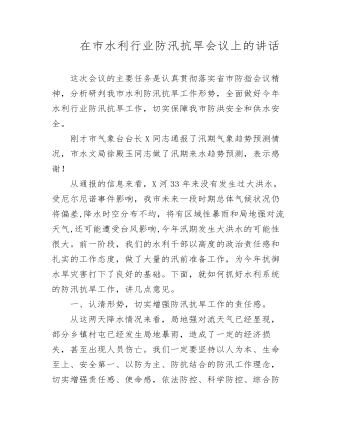
在市水利行业防汛抗旱会议上的讲话
一、认清形势,切实增强防汛抗旱工作的责任感。从这两天降水情况来看,局地强对流天气已经显现,部分乡镇村屯已经发生局地暴雨,造成了一定的经济损失,甚至出现人员伤亡。我们一定要坚持以人为本、生命至上、安全第一、以防为主、防抗结合的防汛工作理念,切实增强责任感、使命感,依法防控、科学防控、综合防控、群防群控,完善细化工作措施,最大程度减轻灾害损失,确保主要江河、大中型水库、重点城镇防洪安全,保障好人民群众生命安全和城乡居民生活用水安全。
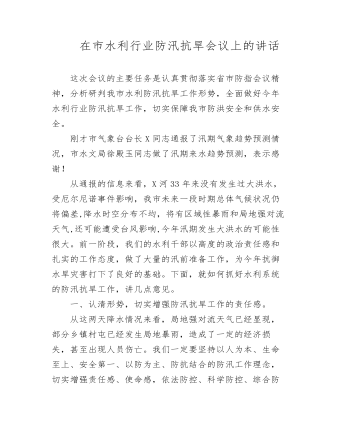
在市水利行业防汛抗旱会议上的讲话
一、认清形势,切实增强防汛抗旱工作的责任感。从这两天降水情况来看,局地强对流天气已经显现,部分乡镇村屯已经发生局地暴雨,造成了一定的经济损失,甚至出现人员伤亡。我们一定要坚持以人为本、生命至上、安全第一、以防为主、防抗结合的防汛工作理念,切实增强责任感、使命感,依法防控、科学防控、综合防控、群防群控,完善细化工作措施,最大程度减轻灾害损失,确保主要江河、大中型水库、重点城镇防洪安全,保障好人民群众生命安全和城乡居民生活用水安全。一要强化思想认识,敢于担当
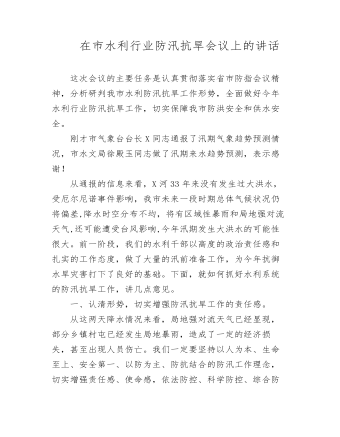
在市水利行业防汛抗旱会议上的讲话发言
一、认清形势,切实增强防汛抗旱工作的责任感。从这两天降水情况来看,局地强对流天气已经显现,部分乡镇村屯已经发生局地暴雨,造成了一定的经济损失,甚至出现人员伤亡。我们一定要坚持以人为本、生命至上、安全第一、以防为主、防抗结合的防汛工作理念,切实增强责任感、使命感,依法防控、科学防控、综合防控、群防群控,完善细化工作措施,最大程度减轻灾害损失,确保主要江河、大中型水库、重点城镇防洪安全,保障好人民群众生命安全和城乡居民生活用水安全。一要强化思想认识,敢于担当。目前,由于机构改革,防汛办公室职能划转,人员转隶调整,容易导致责任空档、工作断挡等问题,做为水利系统的职干干部,越是这个时期,越要体现我们水利人的担当精神,不等、不推、不靠,以前怎么抓,现在还要怎么抓,切实把防汛抗旱的主责记在心里,扛在肩上,克服各种困难,以“宁可十防九空,绝不一次放松”的态度,充分做好“防大汛、抗大灾、抢大险、救大灾”的思想准备和工作准备。二要提高政治站位,明确职责
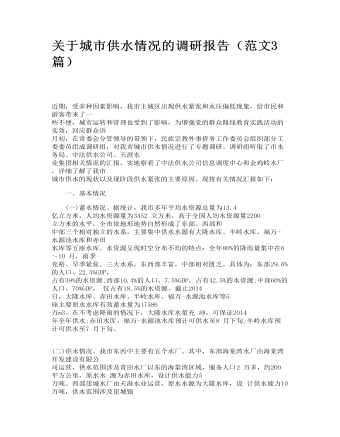
关于城市供水情况的调研报告(范文3篇)
(一)蓄水情况。据统计,我市多年平均水资源总量为13.4 亿立方米,人均水资源量为3452 立方米,高于全国人均水资源量2200 立方米的水平,全市依地形地势自然形成了东部、西部和 中部三个相对独立的水系,主要集中供水水源有大隆水库、半岭水库、福万-水源池水库和赤田 水库等五座水库。水资源呈现时空分布不均的特点:全年80%的降雨量集中在6~10 月,雨季 充裕、旱季紧张。三大水系,东西部丰富,中部相对匮乏。具体为:东部29.6%的人口、22.5%GDP, 占有39%的水资源;西部10.4%的人口、7.5%GDP,占有42.5%的水资源;中部60%的人口、70%GDP, 仅占有18.5%的水资源。截止2014 日,大隆水库、赤田水库、半岭水库、福万-水源池水库等5 座主要原水水库有效蓄水量为17586 万m3。在不考虑降雨的情况下,大隆水库水量充 沛,可保证2014 年全年供水;赤田水库、福万-水源池水库预计可供水至8月下旬;半岭水库预 计可供水至7 月下旬。
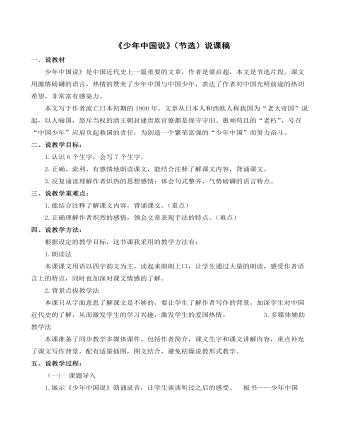
《少年中国说(节选)》说课稿
说教学目标:? 1.认识6个生字,会写7个生字。? 2.正确、流利、有感情地朗读课文,能结合注释了解课文内容,背诵课文。? 3.反复诵读理解作者炽热的思想感情;体会句式整齐,气势磅礴的语言特点。三、说教学重难点:1.能结合注释了解课文内容,背诵课文。(重点)?2.正确理解作者炽烈的感情,领会文章表现手法的特点。(难点)四、说教学方法:? 根据设定的教学目标,这节课我采用的教学方法有:???1.朗读法? ??本课课文用语以四字韵文为主,读起来朗朗上口,让学生通过大量的朗读,感受作者语言上的特点,同时也加深对课文情感的了解。
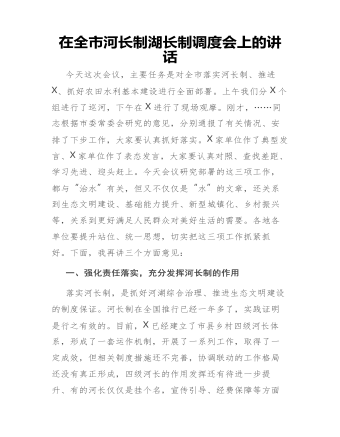
在全市河长制湖长制调度会上的讲话.
落实河长制,是抓好河湖综合治理、推进生态文明建设的制度保证。河长制在全国推行已经一年多了,实践证明是行之有效的。目前,X已经建立了市县乡村四级河长体系,形成了一套运作机制,开展了一系列工作,取得了一定成效,但相关制度措施还不完善,协调联动的工作格局还没有真正形成,四级河长的作用发挥还有待进一步提升、有的河长仅仅是挂个名,宣传引导、经费保障等方面还不到位。
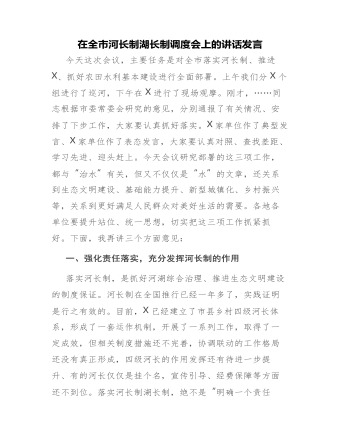
在全市河长制湖长制调度会上的讲话发言
一、强化责任落实,充分发挥河长制的作用落实河长制,是抓好河湖综合治理、推进生态文明建设的制度保证。河长制在全国推行已经一年多了,实践证明是行之有效的。目前,X已经建立了市县乡村四级河长体系,形成了一套运作机制,开展了一系列工作,取得了一定成效,但相关制度措施还不完善,协调联动的工作格局还没有真正形成,四级河长的作用发挥还有待进一步提升、有的河长仅仅是挂个名,宣传引导、经费保障等方面还不到位。落实河长制湖长制,绝不是“明确一个责任人、竖立一块公示牌”就万事大吉,必须通过一套行之有效的制度措施,通过一系列较真碰硬的具体工作,推动河湖综合治理取得实实在在的成效。
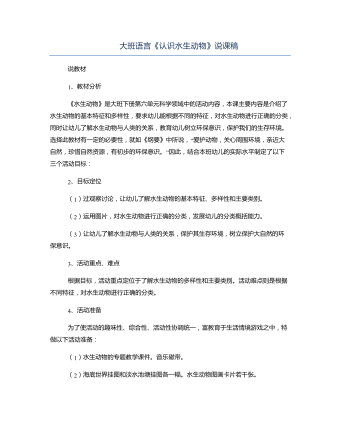
大班语言《认识水生动物》说课稿
《水生动物》是大班下册第六单元科学领域中的活动内容,本课主要内容是介绍了水生动物的基本特征和多样性,要求幼儿能根据不同的特征,对水生动物进行正确的分类,同时让幼儿了解水生动物与人类的关系,教育幼儿树立环保意识,保护我们的生存环境。选择此教材有一定的必要性,就如《纲要》中所说,“爱护动物,关心周围环境,亲近大自然,珍惜自然资源,有初步的环保意识。”因此,结合本班幼儿的实际水平制定了以下三个活动目标:(1)过观察讨论,让幼儿了解水生动物的基本特征、多样性和主要类别。(2)运用图片,对水生动物进行正确的分类,发展幼儿的分类概括能力。(3)让幼儿了解水生动物与人类的关系,保护其生存环境,树立保护大自然的环保意识。
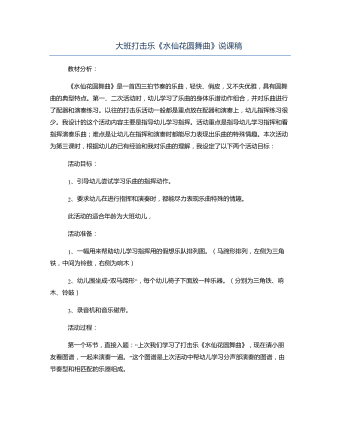
大班打击乐《水仙花圆舞曲》说课稿
重点指导幼儿学习乐曲演奏的指挥动作。首先,激发幼儿学习兴趣,如:“今天,老师要请小朋友来当小指挥,你们有没有信心!”之后,向幼儿出示由各种乐器组成的乐队排列图,与幼儿讨论指挥方法。引导幼儿考虑:“什么手势来表示所有的乐器一起演奏,什么手势表示只有左侧的三角铁演奏。”请个别幼儿示范后,总结出较好的指挥手势。如,双手从头上方向下向外划表示乐器齐奏等。接下来,同样方法讨论空拍怎么指挥,怎么表示准备,怎么表示结束等。下面请幼儿和老师一起听音乐看图练习指挥动作,为让幼儿更清楚的记忆指挥动作,这时老师要背对幼儿,用与幼儿相同的动作方向给幼儿提示和示范。练习几遍后,请全体幼儿看图再次练习指挥动作,体验指挥的乐趣。

